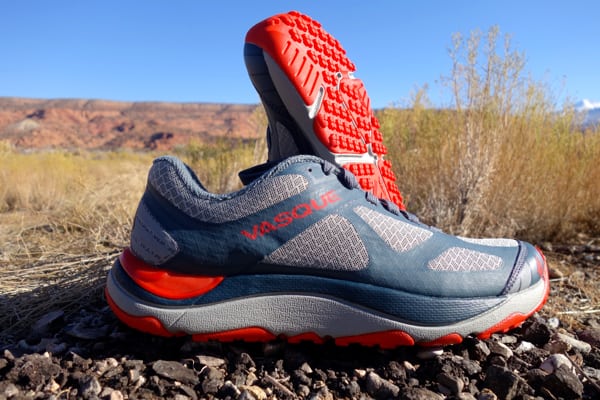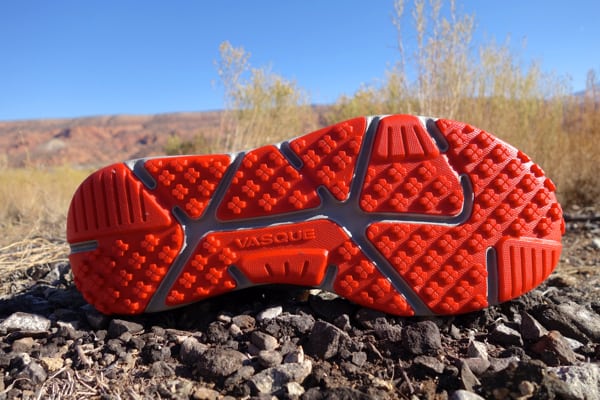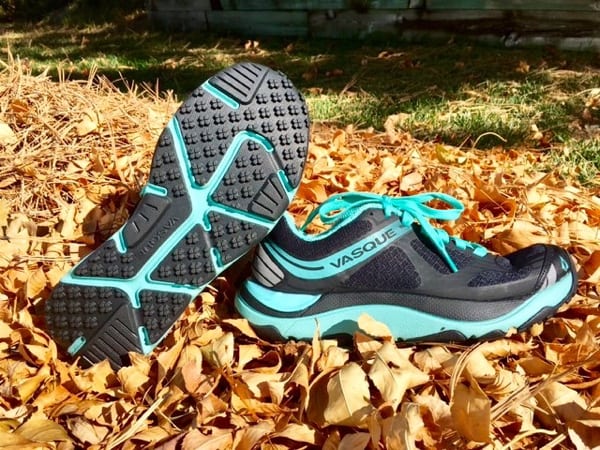Our Favorite Trail Running Shoes
Check out our Best Trail Running Shoes article to learn about our current favorite trail running shoes!
Vasque Trailbender Review
Earlier this fall after more than two years in development, Vasque released three new specialized trail running shoes—the Constant Velocity (8mm drop), Trailbender (6mm drop), and the Vertical Velocity (4mm drop). Each shoe targets slightly different terrain and styles of running. I had the pleasure of reviewing the Constant Velocity back in November, and the shoes are still in my regular rotation of beloved trail-running-enabling footwear. In this review, I’ll highlight key features of the Vasque Trailbender ($129; 9.1 ounces for a women’s size 7/11.4 ounces for a men’s 9) and discuss how it compares to the Constant Velocity. The trio of shoes is currently available in the United States at REI.

The Vasque Trailbender.
VASQUE TRAILBENDER UPPER
The upper on the Trailbender is constructed from an abrasion-resistant synthetic Air Mesh, which looks of uniform pattern throughout the upper. This mesh breathes very well without letting sand and other debris in and dries quickly. The 0.6mm synthetic overlays on the Trailbender are slightly wider and run in a different pattern than on the Constant Velocity. While the overlays do an excellent job of enhancing the structure of the upper, they seem to cause a slight restriction across the top of the toebox along the metatarsal-phalangeal joints. My first 30 miles in this shoe resulted in some redness along the top of my foot directly under the overlay, but after this ‘break-in period,’ the issue resolved. Interestingly, the last of the Trailbender is the same as that of the Constant Velocity, and my own measurements indicate the width of the forefoot is identical between shoes. This stiffer overlay material along the top of the forefoot of the Trailbender is my one complaint about the shoe. It has so many other fantastic qualities, however, so if you have a lower-volume forefoot or don’t mind a brief break-in period, don’t hesitate to try it.
The laces on the Trailbender are flat and hold double knots perfectly; this is a ‘set it and forget it’ lacing system for sure. The simply padded tongue is gusseted two thirds of the way and has no tendency to slip to the side even on rougher terrain. Vasque uses a very comfortable plush terry-cloth-style lining in this shoe. I’m not a sock-less runner, but I almost considered it given the soft, wicking nature of the inside lining. This material did very well wicking moisture and drying quickly, even when I purposefully ran through snow and slush. The 1.2mm synthetic toe cap is further reinforced by an ample 1.25-inch portion of the outsole, which saved my toes a few times and resisted cactus spines exceptionally well. Reflective hits at the heel and toe of each shoe flash brightly when illuminated with headlamps and bike lights from behind.

The Vasque Trailbender’s lateral upper.
VASQUE TRAILBENDER MIDSOLE
The midsole is constructed of injection-molded EVA, which offers the most cushioning of the three new Vasque shoes on the market without sacrificing stability and only slightly decreasing sensitivity to the terrain compared to the Constant Velocity or similar shoes. I didn’t mind this at all because my foot remained secure in the shoe regardless of terrain. To thumb pressure, the EVA feels slightly more dense than the compression-molded EnduraLast EVA of the Constant Velocity. The Anatomical Ortholite X-40 High Rebound footbed is substantial and adds to the cushioning and very comfortable ‘feel’ of the shoe. For those who need a bit more stability for later in the long races, the Trailbender adds the TPU Heel Stabilizer of which I am blissfully unaware of while running and hiking in this shoe. It’s completely unobtrusive yet provides enough support on uneven trail challenges that the sense of fatigue in my ankle stabilizers is reduced. The specs on the Trailbender do not indicate the presence of a rockplate or film. Performance-wise, I didn’t notice the absence at all.

The Vasque Trailbender’s medial upper.
VASQUE TRAILBENDER OUTSOLE
The outsole of the Trailbender features the Micro Plus Sole, which, just like the Constant Velocity’s Traction Plus Sole, is made from the AxisGrip rubber compound. From the nearly 300 miles in my Constant Velocity to the 100-plus miles in the Trailbenders, I can attest to the fact that this outsole is highly resistant to wear and tear. The Micro Plus Sole of the Trailbender has the same pattern of 3mm multidirectional lugs (sets of four pentagons arranged in plus signs around the sole) but the Micro Plus lugs are much smaller and arranged in a higher-density pattern throughout most of the sole. These shoes provide excellent traction on rocks, especially when negotiating prolonged multi-angle slabs like you might find in Utah, the Superstitions of Arizona, and Colorado. The grip was also excellent with wet roots and did as well as can be expected with wet sand on rock. The lugs are small enough that for me, they didn’t excel in mud and snow. However, they also weren’t prone to carrying much clay-mud along for the ride.
The heel crash pad is present only laterally in the posterior aspect of the sole and there are three other similar smaller pads along the sole: one is found medially near the arch, which adds a bit of stability overall, one is laterally, which enhances the sense of control along the fifth ray of the foot in uneven terrain, and the final one is directly under the great toe, which seems to enhance push-off especially on steeper climbs. There are 11 channels cut into the sole, which increase the ability of the shoe to conform to the trail while not sacrificing protection and stability. To me, the sole of the Trailbender feels a bit more dense and protective than the Constant Velocity but not in a way that made me feel limited in my ability to negotiate the trail. The subtle rocker-like ride is still smooth and my confidence on rocky, uneven terrain was on par with the Constant Velocity.

The Vasque Trailbender’s outsole.
OVERALL IMPRESSIONS
I think Vasque has put forth another very strong entry into the trail running shoe market with the Trailbender. For those who prefer the 6mm drop while not sacrificing cushion and stability in the latter miles of a grand adventure, this shoe ranks very highly. The responsiveness, sensitivity, and protection offered by the Trailbender provide an excellent option for a wide range of distances and terrain.
CALL FOR COMMENTS (FROM MEGHAN)
- Have you given the Vasque Trailbender a shot yet? What are your thoughts, if so?
- Has anyone tried more than one of Vasque’s three new offerings? If you have, how do you compare and contrast the models?
- If you have tried the Trailbender, what do you think about the toebox volume?
[Editor’s Note: If you’re affiliated (i.e., an employee, ambassador, etc.) with a shoe brand, please share your relation in each of your comments on this article. Thanks!]

The Vasque Trailbender in one of the women’s color ways.
